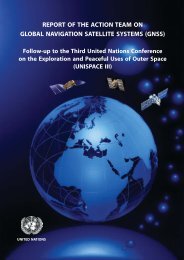Proceedings of the Workshop - United Nations Office for Outer ...
Proceedings of the Workshop - United Nations Office for Outer ...
Proceedings of the Workshop - United Nations Office for Outer ...
- No tags were found...
You also want an ePaper? Increase the reach of your titles
YUMPU automatically turns print PDFs into web optimized ePapers that Google loves.
184 POSSIBLE INTERNATIONAL REGULATORY FRAMEWORKS, INCLUDING LEGALCONFLICT RESOLUTION IN EXPANDING SPACE COMMERCIALIZATIONinto operation at <strong>the</strong> end <strong>of</strong> 1999. The Japan-USsubmarine cable network, due to be operational in <strong>the</strong>second quarter o f 2000, will connect Japan with <strong>the</strong> USmainland via Hawaii. In order to meet <strong>the</strong> increasingdemand <strong>for</strong> multimedia traffic on <strong>the</strong> Japan-Europe andJapan-US routes, <strong>the</strong> planned TAT-14 Cable Networkwill link <strong>the</strong> US mainland with <strong>the</strong> UK, France, <strong>the</strong>Ne<strong>the</strong>rlands, Germany and Denmark, starting also in<strong>the</strong> fourth quarter o f 2000. In March 1998, Gemini, <strong>the</strong>first transatlantic telecoms cable network to caterprimarily <strong>for</strong> Internet traffic entered into service,costing about $ 500 million to lay and which directlyconnects London and New York. There are also anumber o f o<strong>the</strong>r current transatlantic sub-sea cableventures and <strong>the</strong> next generation o f cables due to bedeployed in 2000-2005 is expected to increasetransmission speed capacity tenfold.In fa c t, however, global communications hasremained more a phenomenon that is technicallyfeasible than real in <strong>the</strong> sense <strong>of</strong> having created a true"global village". It is limited to <strong>the</strong> economicallyadvanced regions o f <strong>the</strong> world. Many parts <strong>of</strong> <strong>the</strong> world(developing countries) have still have very limitedtelecommunications penetration. There is clearly animportant telecommunications gap. This problem hasbeen addressed in a number <strong>of</strong> studies, most notably in<strong>the</strong> 1985 report "The Missing Link", produced by <strong>the</strong>Independent Commission <strong>for</strong> W orld-W ideTelecommunications Development (Sir DonaldMaitland, UK, chairman).8 The 1998 edition o f <strong>the</strong>ITU's World Telecommunication Development Reportshows that <strong>the</strong>re has been little progress.9 According tothis report, at <strong>the</strong> beginning <strong>of</strong> 1997 62 per cent <strong>of</strong> allmain telephone lines were installed in only 23 developedcountries (Australia, Canada, <strong>the</strong> European Union,Iceland, Japan, New Zealand, Norway, Switzerland and<strong>the</strong> <strong>United</strong> States), accounting <strong>for</strong> just 15 per cent <strong>of</strong> <strong>the</strong>world population. Although 60 per cent o f <strong>the</strong>population in developing countries lives in rural areas,8 D. Maitland, The M issing Link, Report o f The IndependentCommission For Worldwide Telecommunications Development(1985).9 ITU, World Telecommunication Development Report (8th ed.1998).more than 80 per cent <strong>of</strong> main telephone lines in <strong>the</strong>secountries are in urban areas. With regard to new typeso f networks and services, it is startling to note that 84per cent <strong>of</strong> mobile cellular subscribers, 91 per cent <strong>of</strong>all facsimile machines, and 97 per cent <strong>of</strong> all Internethost computers are located in industrialized countries.Finally, <strong>the</strong>re are more cellular telephones in Thailandthan in Africa, and more Internet host computers inEstonia than in sub-Saharan Africa (excluding SouthAfrica). About half <strong>of</strong> <strong>the</strong> world population has nevereven made even a telephone call.Developments in <strong>the</strong> World TradeOrganization (WTO)An important international trade regime <strong>for</strong> <strong>the</strong>telecommunications industry was established in 1997within <strong>the</strong> new World Trade Organization (WTO) on<strong>the</strong> basis <strong>of</strong> <strong>the</strong> framework <strong>of</strong> <strong>the</strong> General Agreement onTrade in Services (GATS) and <strong>the</strong> WTO Agreement onBasic Telecommunications Services, annexed to <strong>the</strong>GATS.10 The 69 states that have made commitmentsunder this agreement account <strong>for</strong> more than 93 per cent<strong>of</strong> global telecommunications revenue. Among <strong>the</strong>regulatory principles accepted by <strong>the</strong> parties are <strong>the</strong>prevention <strong>of</strong> ant-competitive practices, <strong>the</strong> obligationto provide interconnection on transparent andreasonable terms and <strong>the</strong> requirement <strong>for</strong> independentregulatory bodies and o<strong>the</strong>r commitments facilitatingmarket access.10 See P. Malanczuk, From GATS to WTO - The LegalFramework <strong>of</strong> <strong>the</strong> 1997 WTO Telecommunications Agreement,Telecom International, Vol. 1 (1997), pp. 22-27; P.Malanczuk/H. de Vlaam, International Trade inTelecommunications Services and <strong>the</strong> Results <strong>of</strong> <strong>the</strong> UruguayRound <strong>of</strong> GATT, Telecommunications & Space Journal, Vol. 3(1996), pp. 269-90; A.E. Appleton, Telecommunications Trade:Reach Out and Touch Someone?, University o f PennsylvaniaJournal o f International Economic Law, Vol. 19 (1998), pp.209-227; M.C.J. Bronckers/P. Larouche, TelecommunicationsServices and <strong>the</strong> World Trade Organization, Journal o f WorldTrade Law, Vol. 31 (1997), pp. 5-47; R. Frid, TheTelecommunications Pact Under <strong>the</strong> GATS-Ano<strong>the</strong>r StepTowards <strong>the</strong> Rule <strong>of</strong> Law, Legal Issues o f EuropeanIntegration, Vol. 24 (1997), pp. 67-96.
















